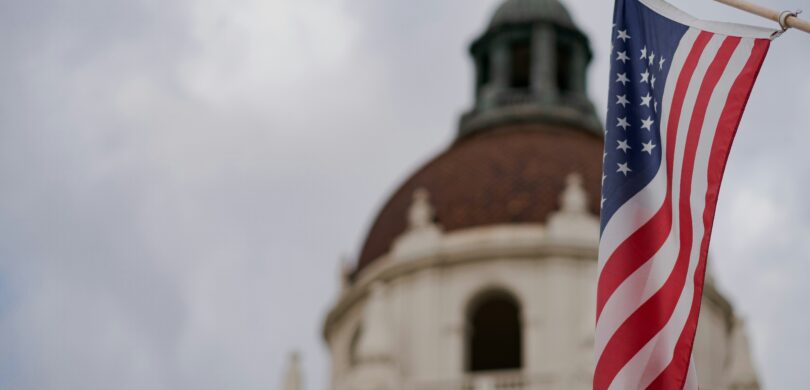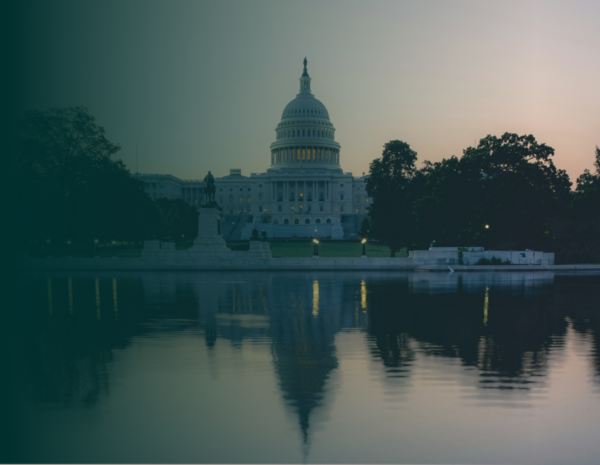In his farewell address, U.S. President George Washington gave a fervent warning against the dangers of political parties. The nation’s first President worried that disagreements between factions would lead to bitter division, encourage corruption, and invite foreign influence.
Though many Founding Fathers agreed at first, they almost immediately began to form political parties. Today, parties play an important role in the political system of the United States. Washington warned of their dangers, but they also have benefits. Political parties:
- Unite people to achieve common political goals
- Help voters learn about candidates and elected officials
- Encourage civic participation
Throughout the course of their history, U.S. political parties have changed a great deal. Examining their past can help you understand their role today.
The History of U.S. Political Parties
Political parties are groups with common political interests that seek to win government elections. U.S. political parties have a history as old as the country itself, but its Constitution did not account for them. Today’s party structure and functions developed over time, starting with the American Revolution.
U.S. Political Parties in the 19th Century
Washington was the only nonpartisan president in American history. Political parties started to emerge in the United States soon after the Revolutionary War.
The Federalist Party supported a strong federal government and the creation of a national bank. The party came together around the views of Alexander Hamilton in 1792 or 1793. Thomas Jefferson and James Madison organized in opposition, forming the Democratic-Republican Party. The Democratic-Republicans saw the Federalists as elitist and called for limited government.
Parties first played a role in a presidential election in 1796. Federalist John Adams narrowly defeated Jefferson, a Democratic-Republican. Before the next election in 1800, members of each party in Congress met to nominate their own candidates. Adams and Jefferson faced off again, and this time, Jefferson won.
The Federalists failed to gain mass support and disappeared in the early 19th century. The Democratic-Republicans split into the Democratic Party and the short-lived National Republican Party, which then joined with others to form the Whig Party. Democrats at this time supported a small central government and low tariffs, and they opposed the national bank. Whigs wanted a strong national government, higher tariffs on imports, and more public works programs.
The Whigs could not agree on the topic of slavery, though. The party broke apart as this issue gained prominence in the 1850s. The Republican Party then emerged in 1854 with an anti-slavery platform. Their presidential candidate, Abraham Lincoln, won the election of 1860. Lincoln then led the country through the American Civil War, preserving the union when Southern states seceded over their right to allow slavery. From that point forward, the two major parties in the United States were the Democrats and the Republicans.
Major Parties vs. Minor Parties
The United States has had a two-party system since the mid-1800s. There is no law establishing two major parties — or any political parties at all. It happened naturally, as different groups fought for victory in the nation’s winner-take-all elections.
Other parties continue to exist, though. These minor parties have changed throughout history, but they have always been a feature in U.S. politics.
Major Parties
The two largest parties in the United States are the Republican and Democratic parties. Since their beginnings, they have changed their platforms and base of support multiple times.
The Democratic Party began in the late 1820s championing individual liberty, states’ rights, and a limited central government. They supported slavery and appealed to more rural Southern voters.
The Republican Party began in the 1850s to oppose the expansion of slavery in America. This new party supported a strong central government, the national bank, and high tariffs on imported goods. Republicans quickly gained support in Northern states.
After the stock market crash of 1929, Democrat Franklin D. Roosevelt won the presidency with his plan for recovery from the Great Depression. His “New Deal” focused on job creation, social welfare programs, and economic reforms. This expanded the role of the federal government and shifted the Democratic Party toward favoring greater regulation and a social “safety net.” The increasingly pro-business Republican Party opposed the New Deal.
The next big shift began in 1964, when Democratic President Lyndon B. Johnson signed the Civil Rights Act into law. His Republican opponent in that year’s election, Barry Goldwater, spoke out against it. Because of Goldwater’s statements on civil rights, most of the Republican party’s black voters left to join the Democrats.
Goldwater and other Republicans had developed a “Southern Strategy” to appeal to white conservative Democrats in the South. This region was historically a Democratic stronghold, but Goldwater won several states there in the 1964 presidential election. He lost in almost every other state, as well as the election itself. Republican President Richard Nixon had more success with the Southern Strategy. In 1972, he won nearly every state and two-thirds of the popular vote.
In modern times, the Republican Party supports conservative social and economic policies, limited federal government, and deregulation. The modern Democratic Party calls for social liberalism, a strong federal government, and robust social services.
Minor Parties
Parties other than the Republicans and Democrats are known as minor parties or third parties. As of 2024, the largest minor parties in the country are the Libertarian Party, Green Party, and Constitution Party.
Minor parties occasionally win seats in local governments, state governments, and Congress. In Congress, third-party candidates typically caucus with a major party, meaning they generally vote together on legislation.
These parties generally do not win presidential elections, but they can influence them. Major parties may adopt minor party positions into their own platforms to gain votes. Rarely, minor parties have had a significant impact on presidential election results.
Former President Theodore Roosevelt left the Republican Party in 1912 to form the Progressive or “Bull Moose” Party. He did this to challenge sitting Republican President William Howard Taft, but the two split the Republican vote. Democrat Woodrow Wilson won the presidency, with Taft coming in third.
In 1992, Ross Perot ran as an Independent — with no political party at all — and received 19 percent of the popular vote. President Bill Clinton, a Democrat, won with 43 percent and Republican George H.W. Bush took 37 percent. Perot ran again in 1996 as a Reform Party member and received about eight percent of the popular vote.
The 2000 Presidential election was so close that Ralph Nader’s Green Party candidacy may have changed the winner. Republican President George W. Bush won over Democrat Al Gore, who liberal Green Party voters would more likely support.
Multiple minor party contenders appeared on ballots in 2016, when Republican President Donald Trump was elected over Democrat Hillary Clinton. Libertarian Gary Johnson received just over three percent of the popular vote, with the best third-party performance since Perot. Jill Stein earned one percent of the vote as a Green Party candidate. It is unclear whether these candidates changed the outcome, though.
The Function and Structure of U.S. Political Parties
In the U.S., the main functions of political parties include:
- Recruiting and nominating candidates for office
- Fundraising to help their candidates get elected
- Encouraging people to vote for their candidates
- Giving voters an easier way to choose between candidates
- Helping elected members achieve the party’s goals
American political parties do not tend to have official rosters or membership requirements. Anyone can declare themselves a member of any political party. Though political parties started out as loosely organized factions, they became more structured over time.
U.S. Political Parties at the Federal vs. State Levels
At the federal level, the major parties have national committees that set the party’s platform — their issue positions and goals. They hold conventions to nominate presidential candidates. However, they do not run their nominees’ campaigns. Instead, they support the campaigns of candidates for President and key elections in Congress.
State chapters of political parties do much the same thing for state-level and Congressional elections. They also name electors for the Electoral College that chooses the President. If the party wins their state, electors pledge to cast their votes for the party’s candidate. The number of electors is equal to the number of the state’s members of Congress.
At the local level, parties focus on local elections and grassroots organizing. In the late 19th and early 20th centuries, local political parties played a large role in their communities. They wielded significant power and influence through a patronage system that rewarded party loyalty. Political reforms have weakened them over the past several decades.
Political parties also take part in primary elections or caucuses to determine their nominees. Until the 20th century, nominees were chosen by party leaders. Primaries for presidential elections began in a few states in the early 1900s. They allowed party members to vote to choose delegates to send to the national convention. Today, most state governments hold primaries, while some allow parties to hold their own caucuses. These elections allow people to vote for candidates they want a party to nominate. In Presidential and Congressional elections, parties send delegates to their national conventions based on primary and caucus results.
Once elected, officials work with other members of their party to achieve common goals. They often vote together, especially on important issues in their party platform. They may work against the opposing party or compromise with them to pass legislation.
Get Started With Plural
As the 2024 elections approach, understanding the role of U.S. political parties is especially crucial. Plural helps concerned constituents and government relations teams alike understand the role of government and public policy in our everyday lives. With Plural, you’ll:
- Access superior public policy data
- Be the first to know about new bills and changes in bill status
- Streamline your day with seamless organization features
- Harness the power of time-saving AI tools to gain insights into individual bills and the entire legislative landscape
- Keep everyone on the same page with internal collaboration and external reporting all in one place
Create a free account or book a demo today!
More Resources for Public Policy Teams
Key Benefits of AI for Lobbying & Advocacy
Want to be able to explain the benefits of artificial intelligence for lobbying and advocacy? Everyone is talking about AI. And we get it, it’s not simple to understand. But as an AI-powered organization, Plural is here to help you get the most out of advancements in AI to make your job as a policy […]
2025 Legislative Committee Deadlines Calendar
Staying on top of key deadlines is manageable in one state, but if you’re tracking bills across multiple states, or nationwide, it quickly becomes overwhelming. That’s why we created the 2025 Legislative Committee Deadlines Calendar. Stay ahead of important dates and download our calendar today. Get started with Plural. Plural helps top public policy teams get […]
End of Session Report: Florida 2024 Legislative Session
The 2024 Florida legislative session saw significant activity in the realm of insurance and financial services, reflecting key themes of consumer protection, market stability, and regulatory modernization.



